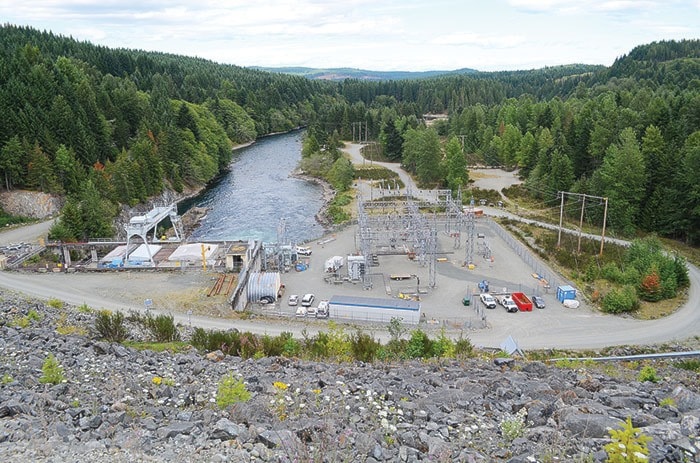The water level in the Lower Campbell/McIvor lakes reservoir started rising Monday but not because of the meagre amount of rain we’ve had over the last few days.
It’s because BC Hydro is raising the level of water in the reservoir in order to have a 32-day supply to accommodate downstream fish and power generation needs.
“The unprecedented weather is causing a situation on the Campbell River hydroelectric system not yet seen by BC Hydro,” company spokesperson Stephen Watson said. “With that comes responsible decision making for a ‘just-in-case’ scenario to protect downstream fish habitat and drinking water supply.”
BC Hydro can pass water downstream of the Strathcona Dam – the first or most upstream dam on the Campbell River system (Ladore, then John Hart dams follow) – by having water go through the generating station or through any of three spillway gates. All the water is currently being passed through the generating station.
There are two generating units in the powerhouse. Generator No. 2 is down for annual maintenance and major capital upgrades that are required for ongoing reliability. The unit is disassembled and is expected to return to service in mid-October. Until then, Generator No. 1 is providing the water flow downstream. The question is, what if the lone operating unit has a major equipment failure and takes weeks to fix? Under such a situation, normally, water would be passed through the spillway gates.
The concern is that the potential water passage through the spillway gates is declining daily as the upstream reservoir level drops. With the Upper Campbell Reservoir/Buttle Lake currently at 215.45 metres, a water release of only 18 m3/s is possible, and it decreases to zero if the level of the reservoir drops to 214.9 metres, the level of spillway gates. The reservoir is forecasted to go below the sill level of the spillway gates in early August. The previous record low Upper Campbell Reservoir level for this time of year was 216.8 metres.
To add to the potential issue of a reservoir level below the sill of the spillway gates coinciding with a failure of Generator No. 1, the same result could take place should a forest fire affect the transmission lines in the area and force the generator out of service.
All three generating stations on the Campbell River system are generally being run in sync, each passing 28 m3/s flow all the way through to the Campbell River below John Hart Generating Station. So if water is suddenly unable to pass downstream of the Strathcona Dam, all the water storage for downstream fish habitat flows and drinking water would have to come from Lower Campbell Reservoir/McIvor Lake.
Out of consideration for reservoir levels outlined in the Water Use Plan and the downstream 28 m3/s minimum fish habitat flow, there would be enough water for about 16 days.
“BC Hydro could go below that minimum level (174 metres) but the risk to water quality, mainly turbidity by quickly drafting a reservoir to a level it’s never been to may be significant,” Watson said. “BC Hydro was aware of this potential situation early in the year with the planned capital works. However, the level of extremely-low water abundance since the spring has extended the duration of the downstream water passage risk to an uncomfortable level.
“Despite the actual risk to the Strathcona facility being low in not being able to pass water downstream from Generator No. 1, the consequences would be high, so the risk needs to be mitigated. It’s a situation not dealt with before.”
Consequently, BC Hydro sought and received a variance from the Comptroller of Water Rights on Monday, with government fish agency support.
Given the unprecedented dry spring and summer, and a review of the operating regime for Upper Campbell Reservoir/Buttle Lake and Lower Campbell Reservoir/McIvor Lake, beginning on Monday BC Hydro started to move more water through Generator No. 1 into the Lower Campbell Reservoir to reduce the consequences if water cannot be released past the Strathcona Dam. This means the Lower Campbell Reservoir will rise about 1.5 metres from 175.8 metres to about 177.5 metres over an eight-day period. This will provide not 16 days, but 32 days of water storage in being able to pass 28 m3/s downstream.
The downstream flow risk is in place for about two months, with the highest potential risk being the month of August. Every passing day reduces the time before the second generating unit at Strathcona is brought back into service. Therefore, a reservoir re-balancing will start taking place in late August.
The Upper Campbell Reservoir/Buttle Lake has a larger storage capacity than the lower reservoir, and this action may translate to a reservoir drop of about 0.8 of a metre over the originally planned operations for this summer.
